![]()
The Words of the Sheftick Family
|
|
The Words of the Sheftick Family |
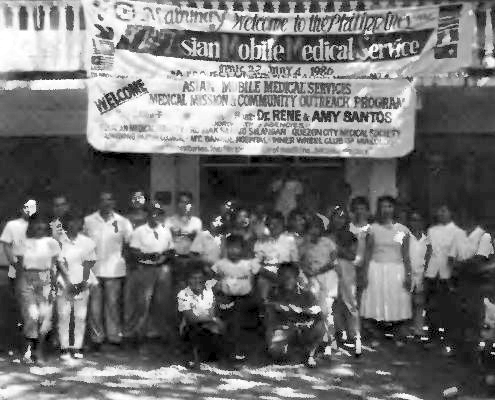
The
medical team is given a warm welcome in Paombong, Bulacan.
Dr. Joseph Sheftick, a church member since 1968, is a chiropractor and reiki teacher currently practicing at the World Mission Center in New York. At the invitation of Dr. Michiko Kozaki, president of the Asian Mobile Medical Service (AMMS) and director of Isshin Hospital, he and Dr. Chet Johnson, a pediatrician, spent a week in 1986 on an AMMS team providing free medical care in the Philippines. Dr. Sheftick spent three subsequent weeks at Isshin Hospital in Tokyo, where he assisted the staff and introduced his reiki and chiropractic techniques to them. This personal account is taken from an interview with Angelika Selle.
I had the opportunity last year, along with Dr. Chet Johnson, to be one of the first two participating American doctors in the Asian Mobile Medical Service in the Philippines. When we-21 doctors and nurses from Japan, Korea, America, Thailand, the Philippines, Hong Kong, and Ireland -- arrived in Manila on April 27, 1986, we were given an enthusiastic reception by Mr. Yoshinobu Murotani, the leader of the Philippine Unification movement, and many of the members. Mr. Ulrich Volkel, the Philippine representative of the International Relief Friendship Foundation (IRFF) was also on hand to greet us.
The next day all the medical representatives gathered together to discuss the kinds of services we would be offering during our one week in the Philippines. Then we divided up into three teams. My team, led by
Dr. Shoichiro Awata from Isshin Hospital, was to go first to the northern part of the country, to the town of Baguio, which is sometimes called the summer capital of the Philippines.
Our journey to Baguio was quite an experience. We left Manila in the afternoon and finally arrived on a one-lane mountainous road in Baguio at 10 pm. Drivers in the Philippines honk their horns constantly, signaling to pass or to give other directions. Between the horns and the crazy way people drove, I was amazed we all arrived safely. But, happily, Mr. Gerry Servito, president of Philippines CARP, and other CARP members were there to give us a big welcome.
I didn't want to go to my hotel room right away, so I went for a walk around the city, accompanied by a Filipino brother. There were very few people walking around at that late hour. We came across a little girl, about 6 or 7 years old, curled up and sleeping in a doorway. She was dirty and ragged and had a display box of chewing gum and candy in her lap. She had been trying to sell candy all alone at 11 o'clock at night but just couldn't keep going. It was heartbreaking to actually see someone in that kind of situation -- struggling to barely survive. I went back to my hotel and cried and cried for several hours. I determined that while I was in the Philippines and a part of this team, I would give as much as I possibly could.
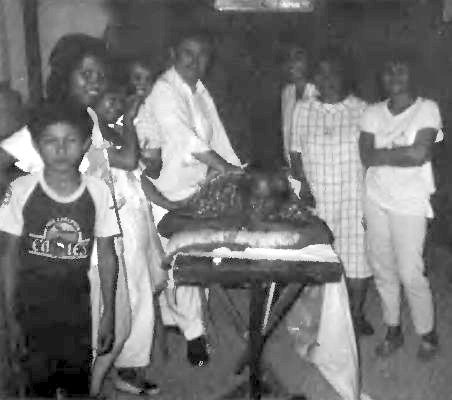
In
Apalit, Dr. Sheftick treats a patient as friends and family gather
around.
The next morning, Gerry Servito, who helped coordinate our activities, took us out to a very poor section of the city, which they call the barrio. Our clinic was set up in a local elementary school -- a building made of cement blocks with only a dirt floor. We worked there continuously from 8 or 9 am to 6 pm, without food or a break. There wasn't time. Hundreds of people, including children and infants, were lined up outside, waiting in the blazing heat. It really showed me the desperate need for medical care in the Philippines. Per capita, there are only one fourth as many doctors in the Philippines as there are in the United States, but even those doctors are unavailable to most of the people because they are so poor.
I understand that in some areas, between 40 and 60 percent of the people never see a doctor in their lifetime. Most even die without seeing one. I was shocked to see such poverty.
The people of Baguio had a great need for minor surgery and especially dental work. Dentistry is one of the most popular parts of the AMMS service everywhere in the Philippines, because the people can't afford dentists. They usually have their teeth pulled rather than filled because of the expense of refilling the cavities. Our team pulled out hundreds of teeth in one day. We also made false teeth right on the spot.
I offered chiropractic treatments and used reiki. Chiropractic is a health discipline based on the premise that disease can result from misalignments of the vertebrae, which then interfere with the nervous system. Chiropractors manipulate and adjust the spine to remove the interference. Reiki originated in Tibet and can be described as an Eastern vibrational science. It was rediscovered by Dr. Mikao Usui, a Japanese scholar. The inherent purpose of reiki is to give direct access to transcendental universal light energy, which can then be applied in the healing process of a person on the spiritual, psychological, and physical dimensions. I always use chiropractic and reiki in combination.
Both chiropractic medicine and reiki are unknown in the Philippines, although the town of Baguio is, ironically, famous for its practitioners of psychic surgery. Because my methods were unfamiliar to the doctors and nurses of my team, they became my first patients -- out of curiosity. They even had me give them a lecture on chiropractic.
At the end of our long day, all of us were invited to a special dinner hosted by the president of the University of Baguio, President R. Bautista.
In one week our team traveled to three different towns, setting up our temporary clinic in each one. Everywhere we went, there were so many people waiting to see us we couldn't take any breaks. The people who assisted us, whether they were Unification Church members or not, supported us continuously. One day I treated patients for 12 hours straight, and the Filipino woman who worked with me stayed with me every moment. She wouldn't eat anything until I finally stopped to eat. It was an incredibly humbling experience to see that kind of love and dedication.
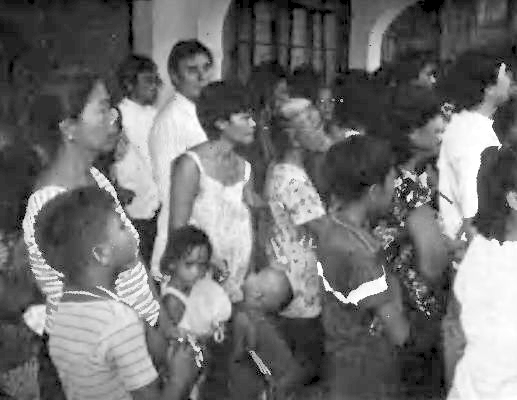
In
Paombong, the crowd waits patiently for the clinic to open.
I've never seen people offer such gratitude for receiving only minor medical care! Sometimes we had crude equipment to work with, but there was something special about these clinics. The patients who had been treated would stay around and support the other patients, joking and laughing in order to calm those who were nervous. Since it was a new experience for everybody, they would tell the new patients when to get up on the table, and they would say, "Don't worry, it won't hurt:" It was touching to see a whole community taking care of each other as one extended family.
The patients ranged from the very young to the very old, and they had all kinds of problems. Besides dental work, we distributed vital medicines brought in from Japan, did minor surgery to remove small growths, cleaned infected wounds, and even did circumcisions. I remember in one city, six or eight boys aged 10 to 12 were lined up on a table. Usually boys are circumcised as infants as a religious tradition, but there weren't any doctors who could do this. So the nurse gave them all local anesthesia, and the doctor came in and circumcised them one after the other.
Our ophthalmologist, Dr. Hiroshi Shiraishi, who is the secretary-general of AMMS, was able to do some corrective eye surgery. He was also called to examine the eyes of a former vice president of the Philippines and his wife, who invited him to have lunch in their home.
After our tour, all three teams met back in Manila, where we provided medical care for the Unification Church members. Even though some of our members had pressing medical needs, they waited until we had gone out to the poorest areas of the country first. We arrived in Manila at 5 pm and worked non-stop with the members til 4:30 am. I don't know how many we took care of. When I offered to treat the Filipino sister who was assisting me, she kept saying, "I'll wait until your last patient" So she waited until almost 5:00 in the morning to be treated.
On our final night there, a farewell banquet was held for us at the Philippine Plaza Hotel, and the AMMS received a special plaque in gratitude for our service to the people of the Philippines. The assistant mayor of Manila, the Korean ambassador to the Philippines, and President Aquino's minister of health, as well as presidents of various medical societies, attended and congratulated us on our work. One of the presidents of a medical society, and an organizer and staunch supporter of AMMS, is Dr. Rene Santos, the grandson of the famous General Santos who fought with General MacArthur to liberate the Philippines in World War II.
During this project we treated a total of 3,688 people -- all free of charge. But my experience with AMMS means far more to me than just numbers. It was enlightening to work with doctors from so many different nations. I believe doctors need to work together. We are responsible for alleviating human suffering directly, so our motivation to serve others should come out of an understanding that we are all brothers and sisters -- the family of God, our parent. Because the AMMS is based on such a strong foundation of love, it offers a very good way to help create this unity.
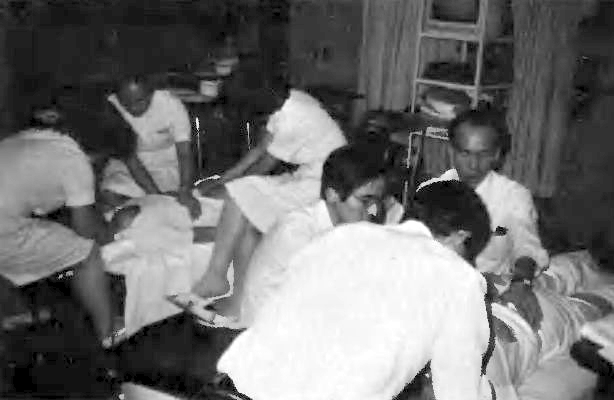
The
doctors and nurses at Isshin practice newly-learned reiki techniques
on each other.
After the AMMS program in the Philippines, I was invited by Dr. Kazaki to spend three weeks working at Isshin Hospital in Tokyo. I provided reiki and chiropractic care for the patients and even the hospital staff. The orthopedics department was overloaded with patients, so I helped examine some of them. In the physical therapy department, I worked with patients who had muscular and skeletal problems of the back, neck, shoulders, and arms, as well as internal problems.
Watching my techniques was a new experience for the Isshin medical staff. Only one staff member had ever worked directly with a chiropractor, so I gave them a lecture on chiropractic, and out of curiosity some of the staff came to me for treatment.
Although reiki is a Japanese word, and the woman who introduced it to the West was Japanese, reiki is not well known in Japan. Even the name itself has little meaning to them. But when I showed them my business card with the Japanese characters for reiki printed on it, they seemed to grasp a deeper meaning.
The staff was very receptive and wanted to learn anything that was of potential value in helping their patients. For instance, a child came into the emergency room about 1:00 am with a severe asthma attack. After I did about 20 minutes of reiki on him, the attack ended and his breathing became clear. The emergency room nurse was so impressed that she insisted on learning reiki herself to use in emergency situations. In all, I taught nine staff members, both doctors and nurses, to use basic reiki techniques.
While I was in Tokyo, I had the opportunity to visit Dr. Hiroshi Motoyama, the head of the International Association for Religion and Parapsychology. As both a Shinto priest and a scientist, he is trying to unify science and religion, and he is known worldwide for the work he does. He has pioneered the development of an instrument to measure the human energy system for diagnostic purposes. Utilizing computers, this instrument is about 80 percent accurate. It measures the energy along the acupuncture meridian lines and in the seven major chakras, which are vortices of energy located in different areas of a person -- the crown, brow, throat, heart, stomach, spleen, and the base of the spine.
I went to be tested by Dr. Motoyama along with Dr. Awata, who acted as my translator. Dr. Motoyama did readings on both of us before and after I did 20 minutes of reiki on Dr. Awata. The readings taken afterward showed a higher and more balanced energy level in both of us. That indicated to me that even the person who applies reiki energy to another person benefits.
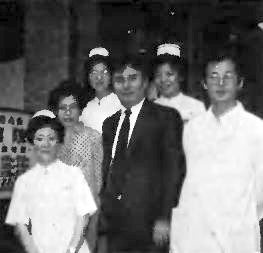
Dr.
Sheftick with some of the staff at Isshin Hospital.
One striking aspect of Isshin Hospital is the warm relationship of trust that exists between the doctors and the patients. I used reiki on one elderly woman who had been suffering from asthma. After about 10 minutes of treatment she began to cry. She told me through Nurse Mieko Yoda, my interpreter, that she felt God's presence, and she asked me to come closer to her. Then she touched my face and began to cry even more. Then both Mieko and I began to cry, and we kept crying for about 10 or 15 minutes. It was an unbelievable experience.
I visited another woman who was recovering from a cancer operation during which her right lung had been removed. She was still in great pain. Her breathing was restricted, and her voice was very weak. After the first reiki treatment she began to improve, and by the fourth treatment the pain had gone, and her breathing and voice were much stronger. She had been going every day to the hospital's morning service but was now able to sing the holy songs with everyone else. She was so impressed and grateful that she occasionally followed me around the hospital, introducing me to the other patients. Her response to me was totally different from the way most patients respond to health care in the West. In America, doctors are not usually looked upon with such love and gratitude. I was completely amazed.
I also helped deliver three babies while I was there. I stayed with each of the women for three to five hours, using reiki. Incredibly, two of the mothers experienced no pain at all during labor. They felt contractions but no pain. On my last night in Japan, at 12:30 am, I went to help out with another woman in labor. When I walked into her room, she began to yell in English, "Doctor, doctor, please do something! Cut it out! I can't take it anymore! It's killing me!" I found out that she had been in labor for 16 hours. She had been vomiting and was totally exhausted.
I began using reiki on her. Within an hour she stopped yelling. The pain stopped and she fell into a very relaxed sleep. She would wake up for the contractions every five minutes and then fall asleep again. I was wondering when the baby would come, because I had to leave for the airport at 6 am, but I continued the reiki. A baby girl was finally born painlessly at 5:23 am. The woman's whole attitude was changed, and she couldn't stop thanking me for staying with, her the whole time.
Working on the Isshin maternity ward was a wonderful surprise for me and very special. Holy songs playing softly in the background gave the place a very holy and pure atmosphere. I had attended my wife in the birthing of our own children, but that experience was totally different from the spiritual feeling surrounding this hospital. I wish every hospital could provide this quality of treatment.
I was also struck by the beautiful loving nature of the doctors and nurses. They really gave of themselves to the newborns -- and to all the patients. I saw there was a very harmonious cooperation among the whole medical staff, most of whom are Unification Church members. I think it must be because of the relationship our members have with God and True Parents. For them it's not just a job; they serve truly out of love. I can see that the love of God makes all the difference.
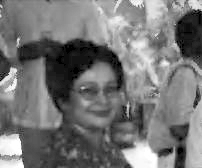
Michiko
Kozaki
When we came to the Philippines for the first time in 1984, I was asked by one Filipino doctor, "Why did you choose the Philippines as the place to do your medical service?" Today, my answer is still the same:
"The Philippines is a land that God loves very dearly. As God loves this land, so do we"
In the past, the Asian Mobile Medical Service has served Korea, Taiwan, Indo-Chinese refugees, the Central African Republic, Zaire, Zambia, Senegal, Sudan, and other nations. We always felt compelled by God's love to go there as well as to come here, now for the third consecutive year.
Certainly, we feel the Philippines has a special place in God's heart. Why is it, then, that a country so close to God must experience so many political and economic difficulties? My answer to that question is: As long as evil exists in the world, Satan tests the country that God loves. When such trials are overcome in love and faith, God will give His blessing. However, many nations that have been blessed in the past have failed to protect and safeguard that blessing. The Philippines is standing at the threshold of receiving God's blessing. A new chapter in your national life is beginning. Therefore, we feel the urgent need to recover and protect the values that your nation is proud of having inherited as the only predominantly Christian nation in the East.
That's why we came here to participate in the spirit of Asian brotherhood and concern, using medical service as a humble way to call all peoples and nations to become ambassadors of God's true love.
The Asian Mobile Medical Service (AMMS) is a volunteer medical team sponsored jointly by Isshin Hospital, the International Relief Friendship Foundation (IRFF), the Professors' Association for the Research of Principles (PARP), the Collegiate Association for the Research of Principles (CARP), and HSA-UWC. Father initiated the Asian Mobile Medical Service as an opportunity for health professionals to devote themselves cooperatively to the severe health problems existing in Asia, but it has already gone far beyond Asia. Composed of doctors, nurses, and medical practitioners from Asia, Europe, and America, the AMMS has been providing free medical and dental service annually for needy people in Korea, Taiwan, Japan, Indonesia, the Philippines, and other countries over the last 17 years. In addition, two teams are permanently stationed -- one in Thailand serving Vietnamese and Cambodian refugees, and one in Zambia. The AMMS seeks not only to provide health care to those in need, but to promote cooperation in humanitarian outreach and to demonstrate a spirit of international brotherhood.
Korea 1971-1983 (one week each summer)
Okinawa 1971-1978 (one week each spring and summer)
Taiwan 1971 (one week in April)
Indonesia 1977 (two weeks in August) Thailand 1979- (ongoing at Sikhiu Vietnamese refugee camp)
Zaire 1980-1981 (two months in summer)
Republic of Central Africa 1982 (three months in summer)
Zambia 1982- (ongoing)
Philippines 1984-1986 (one week each summer)